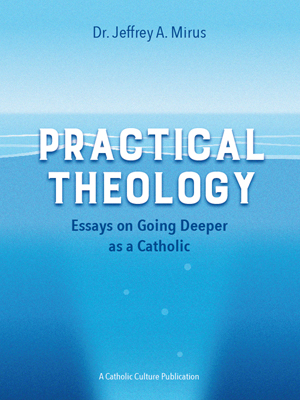Pope Francis’s Funeral and Tomb Showcase His Legacy
By David G. Bonagura, Jr. ( bio - articles - email ) | Apr 22, 2025
In one of his final acts at the Church’s supreme liturgist, Pope Francis revised the rites for papal funerals so that they are tailored for a pastor and bishop, not an earthly monarch. The funeral prayers were revised to express this reality; the pre-funeral mourning rituals were simplified; the pope will now be entombed in a single coffin rather than three. Such changes continued, and now have codified for the future, what is arguably Francis’s most prominent legacy: the retirement of the papacy’s pomp and splendor.
Since the day of his election, when he refused both to don the papal mozzetta to greet the world and to move into the apostolic palace, to the revised funeral rites, Francis, the first pope from the New World, did all he could to break the papacy’s regal connections to the Old World. Now, with his funeral upcoming, the world will see the final act of this drama.
Before his death, Francis also made stipulations for popes to be buried outside of St. Peter’s, a practice once common though not practiced since Leo XIII (r. 1878-1903) was entombed in St. John Lateran. The Argentinian pontiff announced years ago that he wished to be buried in the Basilica of St. Mary Major, the world’s oldest church dedicated to the Blessed Mother. His choice is fitting: his devotion to Mary was palpable, and throughout his pontificate he visited this church to pray before the Salus Populi Romani icon, which tradition attributes to St. Luke the Evangelist.
This basilica was also an ironic choice, emblematic of a pope who, whether the issue was moral teaching, liturgy, or governance, often said one thing and did another. Throughout his twelve-year reign, Francis vehemently opposed worldly grandeurs—for himself and for his clergy. Yet the first pope from Latin America, known for his embrace of poverty, will rest beneath a ceiling adorned with gold from the New World that Christopher Columbus transported and gave to the Church’s most infamous pope, Alexander VI. In an anti-imperialist age, a man from among the conquered has chosen to lie under the spoils of conquerors.
This raises two questions: What type of tomb will Pope Francis have, and how does it speak to his legacy? Tombs of popes and other heads of state do not merely hold the rulers’ earthly remains. They convey how the rulers wish to be remembered. They can also express other messages to posterity, typically ones that the rulers held most dear.
Rome’s papal monuments
Fabulous marble tombs of many of Francis’s 265 predecessors decorate the churches of the Eternal City. Their styles are indicative of both their occupants and the epochs in which they lived. St. Mary Major houses six of Francis’s predecessors whose monuments showcase the worldly grandeurs of late Renaissance and Baroque Catholicism and the power of the sovereign pontiff. Clement IX (1667-1669) and Nicholas IV (1288-1292) flank the basilica’s main doors. Both sit on thrones wearing the triple tiara, the now retired crown that long symbolized the pope’s authority over the Church and the world. To the right of the main altar in the Sistine Chapel rests Pope St. Pius V (1566-1572), whose incorrupt body lies beneath his triumphant monument. Across the way, Sixtus V (1585-1590) chose a more pious representation: wearing a stole and mantum, he kneels in prayer. His tiara rests on the floor next to his knees.
The Pauline chapel to the left of the main altar, where the Salus Populi Romani resides, would be a fitting place for Francis given his devotion. Yet here he would take up residence with Clement VIII (1592-1605) and Paul V (1605-1621), whose triumphant sitting and pious kneeling tableaus mimic those of their immediate predecessors across the nave.
More recent monuments showcase the post-Vatican II Church’s gradual movement from worldly pomp to humble service that Francis accelerated—and likely made permanent. St. Peter’s Basilica features Pope Pius XII’s monument, which, while clearly reminiscent of the Renaissance tradition, showcases a small token of change: the pope wears a bishop’s mitre, not a tiara.
For Pope St. John XXIII, rather than a free-standing monument, Emile Greco crafted a bronze bas-relief that depicts a troubled-looking pope blessing a group of suffering people. His successors—Paul VI, John Paul I, John Paul II, and Benedict XVI—do not have monuments. Their bodies remain in the basilica grotto, except for John Paul II, whose body has been placed in the altar of the St. Sebastian Chapel—without a monument.
Sending the right message
Given Francis’s preferences, it is highly unlikely that he would reside in an ecclesial palace with a grand monument for all eternity. More to his style would be to reject a tomb and instead be buried in the floor, as some cardinals and basilica canons have been. The floor of St. Mary Major also contains the earthly remains of the eminent sculptor Bernini, with the ironic Latin epitaph, “Gian Lorenzo Bernini, glory of the arts and of the city, humbly lies here.”
The choice of the floor over a tomb would break rank with his predecessors, another repeated feature of Francis’s pontificate. Yet his non-monument could too easily be interpreted not as an act of humility, but as a rebuke of his predecessors, especially of his six fellow basilica-occupants for their opulent monuments.
Though contrary to his nature, a tomb and funerary monument would be a fitting way to honor Francis. Properly done, it could convey an authentic legacy true to himself that could transcend papal politics. By adopting a Renaissance model and tuning it to the contemporary Church and to his pontifical priorities, Francis could speak directly to the world and to posterity.
What could such a monument look like? It could include Francis’s virtues: his love for Christ, for Mary, and his belief in the power of the cross. It could include his preference for simplicity over worldly things. It could include his pastoral solicitude for the suffering, for the poor, and for people on the margins of society and of the Church.
Francis’s funerary monument could be a life-sized marble sculpture of him during the signature moment of his pontificate: standing in prayer, wearing his unadorned papal cassock, before the Salus Populi Romani, begging God to spare the world from the Covid-19 pandemic that had taken so many lives and disrupted so many others. In an empty St. Peter’s Square on March 27, 2020, Francis showed billions of people that salvation comes not from science nor from worldly goods, but from Jesus Christ.
The monument could be placed above the entrance doors of the Pauline Chapel, so the marble Francis could gaze directly at his beloved icon that is displayed in the center. His right hand could extend in supplication toward the icon, as it did on that memorable day.
Though sometimes lost in the daily papal dealings, salvation in Christ through Mary was the core message of Francis’s pontificate. Should a sculptor be commissioned to fashion an expensive funerary moment, it could make his message more lasting than bronze.
All comments are moderated. To lighten our editing burden, only current donors are allowed to Sound Off. If you are a current donor, log in to see the comment form; otherwise please support our work, and Sound Off!








